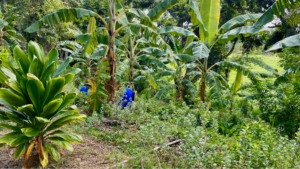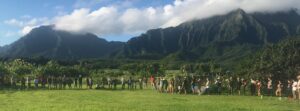Agroforestry
Home » Focus Areas » UHERO Environment » UHERO Environment – Topics » Agroforestry
UHERO Researchers
Agroforestry systems, or the intentional combination of trees and crops (or livestock), are common around the world and are known to provide a suite of socio-ecological and economic benefits. ʻŌiwi (Native Hawaiian) agroforestry systems were widespread prior to European colonization, and likely produced as much or more food than loʻi kalo systems.* While these systems declined after colonization, there is great interest in their restoration today for multiple cultural, ecological, and economic motivations. However, despite these motivations and the availability of fallow agricultural lands and low-priority (invasive dominated lower elevation) conservation lands, there are many obstacles to their restoration in a modern context. In response, UHERO Environment collaborates with an interdisciplinary team of researchers and practitioners (see below) to support restoration of these systems through applied research and adaptive management. This work includes:
- Applied social-ecological research and co-management of a community-based agroforestry restoration site (Puʻulani) in Heʻeia, Oʻahu in collaboration with Kākoʻo ʻŌiwi and the Heʻeia NERR. The team is systematically tracking changes in plant diversity, carbon storage, soil health and microbes, and cultural uses and values. Read more about the Puʻulani biocultural restoration project here.
- Supporting a network of ʻŌiwi-led organizations practicing agroforestry across Hawaiʻi.
- Evaluating the potential of agroforestry systems to be included in ecosystem services incentives tied to carbon storage, sediment retention and links to coral reef, and hydrologic services. Read more about our multi-scale modeling work here.
Key collaborators in this work include Kākoʻo ʻŌiwi, the Department of Life Sciences (Dr. Tamara Ticktin), the US Forest Service (Dr. Zoe Hastings Silao), the Pacific Biosciences Research Center (Dr. Kiana Frank), the Department of Natural Resources and Environmental Management (Dr. Clay Trauernicht, Dr. Susan Crow), Kamehameha Schools (Dr. Natalie Kurashima), and the Heʻeia NERR (Dr. Kawika Winter). UH students have been key leaders in this work including Zoe Hastings Maile Wong, Angel Melone, Tressa Hoppe, Matthew Kahoʻohanohano, and others. Mahalo to those who have supported this work through funding including the University of Hawaiʻi Sea Grant College Program, the Natural Resources Conservation Service, the Kaʻulunani Program (DOFAW), and others.
*Kurashima, N., Fortini, L. and Ticktin, T., 2019. The potential of indigenous agricultural food production under climate change in Hawaiʻi. Nature Sustainability, 2(3), pp.191-199.
Recent Products




